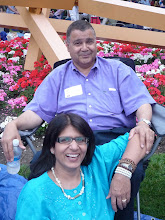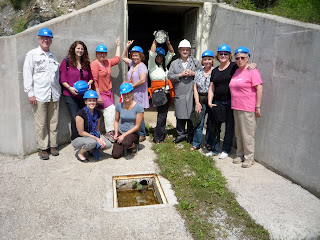 Pilav Tepe –I think of the Indian rice dish Pulao or Pilaf heaped on the plate! That’s exactly what this little mountain 14 km outside Radovish, in the north central part of Macedonia is called. This picture though, is across the Pilav Tepe peak and is the one set up for rock-climbing - with different levels of difficulty. This whole area lies south of the great rice fields of Kochani, so the people who moved here must be missing their rice and imagined this huge helping when they decided to settle here a couple thousand years ago.
Pilav Tepe –I think of the Indian rice dish Pulao or Pilaf heaped on the plate! That’s exactly what this little mountain 14 km outside Radovish, in the north central part of Macedonia is called. This picture though, is across the Pilav Tepe peak and is the one set up for rock-climbing - with different levels of difficulty. This whole area lies south of the great rice fields of Kochani, so the people who moved here must be missing their rice and imagined this huge helping when they decided to settle here a couple thousand years ago. Two adventurous Macedonians – one a certified climber and the other a biker, purchased an old cottage with the help of an American friend 3 years ago with a dream of building a thriving small scale business geared to entry-level extreme sports. I along with 5 other volunteers jumped in to help with the refurbishing and decorating of the mountain house with 2-bedrooms (3 bunk beds each –sleeping a total of 12 people), a modern bathroom and a common kitchen area in exchange for an experience to do some rock-climbing, albeit one of us was a certified director of rock-climbing herself back in the States. We were given the soft tasks in the remodeling event, while the Macedonian volunteers took care of building kitchen cabinets, laying the bathroom tile, installing the plumbing, including the sewage drain, and installing the bathroom fixtures. A lot of this work was completed before our arrival. Our tasks of painting, sewing curtains, washing donated kitchen paraphernalia, putting up posters was just as important to makes this empty house into a welcoming weekend place.
Two adventurous Macedonians – one a certified climber and the other a biker, purchased an old cottage with the help of an American friend 3 years ago with a dream of building a thriving small scale business geared to entry-level extreme sports. I along with 5 other volunteers jumped in to help with the refurbishing and decorating of the mountain house with 2-bedrooms (3 bunk beds each –sleeping a total of 12 people), a modern bathroom and a common kitchen area in exchange for an experience to do some rock-climbing, albeit one of us was a certified director of rock-climbing herself back in the States. We were given the soft tasks in the remodeling event, while the Macedonian volunteers took care of building kitchen cabinets, laying the bathroom tile, installing the plumbing, including the sewage drain, and installing the bathroom fixtures. A lot of this work was completed before our arrival. Our tasks of painting, sewing curtains, washing donated kitchen paraphernalia, putting up posters was just as important to makes this empty house into a welcoming weekend place.  The hiking trails leading to the taller and more difficult rock faces in the adjacent picture, had been created and marked with signs throughout the forest with colorful red and white stripes. These markings on wood and on stone were at every possible fork to guide us even if we lost sight of each other. We did exactly that, when we encountered a land turtle and a few of us stopped to take pictures!
The hiking trails leading to the taller and more difficult rock faces in the adjacent picture, had been created and marked with signs throughout the forest with colorful red and white stripes. These markings on wood and on stone were at every possible fork to guide us even if we lost sight of each other. We did exactly that, when we encountered a land turtle and a few of us stopped to take pictures!Macedonian countryside in spring is filled with a wide variety of colorful flora from the bright red poppy and yellow buttercups to purple, pink, white, lavender and blue wildflowers that I am tempted to gather them in armfuls and bring them in to decorate the house. Alas, I have digressed a little! Back to rock climbing in Pilav Tepe.
I was able to choose a rock climbing shoe that fit me, from the clubs collection. They look like sturdy moccasins’ and stretch, mostly in width, but not in length It had a strong heel and high cut upper leather around the toes and ankles, designed to grip the juts in rock face with the toes. Shoes for rock-climbing are extremely important so they don’t slip and slide but grip the rock face and I am grateful I was able to find a perfect-fit pair, unlike some of my colleagues.
Next was the harness, which I stepped into and adjusted both around my upper thighs and the belt around the waist. It had a number of elements to it, but in my first descent I was carrying nothing other than the belaying rope for security, so I don't know what they are for. The belay rope is a security device. Though, for my short climb, it’s primary function was to provide for a smooth descent. It was so comfortable to “sit in” when I took my hands off the rock and leaned back into the seat holding the belay rope and pushing off the rock in a series of jumps. The belay rope was attached to my harness with some fancy knots and looped at some high point in the rock face and back down into the loop of the belayer, who controlled the length of rope slowly during ascent and descent for security in case of a fall.
 |
| My second climb |
The climbing on the first two days and the 3-hour hike in the morning of the day of return to site, on a portion of the steep ascent the biking path takes up the hill from the cottage, past a monastery and through an old village is for the physically fit. The bikers descend down to Mantovo Esero (lake) near Radovish and loop back to the cottage, while we returned the way we walked up!
For a small developing country there are a lot of hidden gems for recreational activities – from the passive sun-bathing on the shores of beautiful Lake Ohrid, to beginner level extreme sports such as rock-climbing, white water rafting, para-sailing or hang-gliding during the weekends at a local spot nearby!
For a small developing country there are a lot of hidden gems for recreational activities – from the passive sun-bathing on the shores of beautiful Lake Ohrid, to beginner level extreme sports such as rock-climbing, white water rafting, para-sailing or hang-gliding during the weekends at a local spot nearby!










